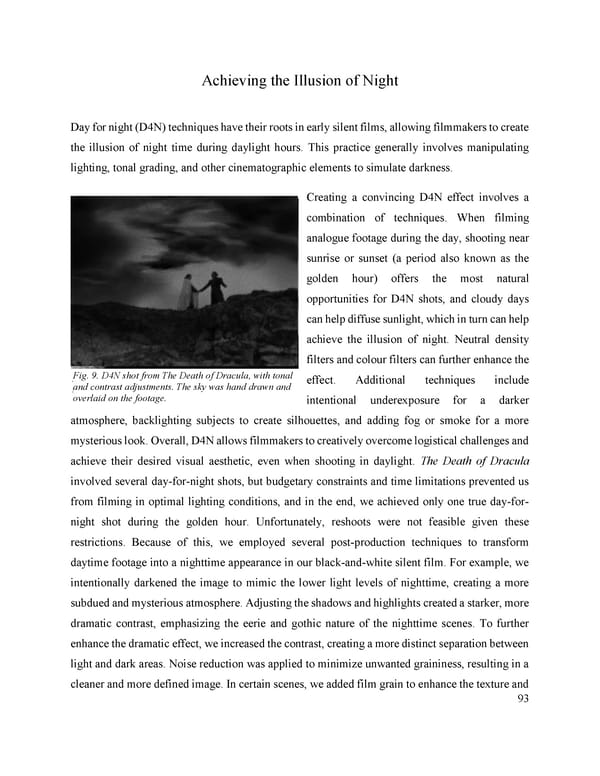Achieving the Illusion of Night Day for night (D4N) techniques have their roots in early silent films, allowing filmmakers to create the illusion of night time during daylight hours. This practice generally involves manipulating lighting, tonal grading, and other cinematographic elements to simulate darkness. Creating a convincing D4N effect involves a combination of techniques. When filming analogue footage during the day, shooting near sunrise or sunset (a period also known as the golden hour) offers the most natural opportunities for D4N shots, and cloudy days can help diffuse sunlight, which in turn can help achieve the illusion of night. Neutral density filters and colour filters can further enhance the Fig. 9. D4N shot from The Death of Dracula, with tonal Analogue D4N shot from The Death of Dracula, filmed effect. Additional techniques include and contrast adjustments. The sky was hand drawn and right before sunset on 16mm black-and-white film. overlaid on the footage. intentional underexposure for a darker atmosphere, backlighting subjects to create silhouettes, and adding fog or smoke for a more mysterious look. Overall, D4N allows filmmakers to creatively overcome logistical challenges and achieve their desired visual aesthetic, even when shooting in daylight. The Death of Dracula involved several day-for-night shots, but budgetary constraints and time limitations prevented us from filming in optimal lighting conditions, and in the end, we achieved only one true day-for- night shot during the golden hour. Unfortunately, reshoots were not feasible given these restrictions. Because of this, we employed several post-production techniques to transform daytime footage into a nighttime appearance in our black-and-white silent film. For example, we intentionally darkened the image to mimic the lower light levels of nighttime, creating a more subdued and mysterious atmosphere. Adjusting the shadows and highlights created a starker, more dramatic contrast, emphasizing the eerie and gothic nature of the nighttime scenes. To further enhance the dramatic effect, we increased the contrast, creating a more distinct separation between light and dark areas. Noise reduction was applied to minimize unwanted graininess, resulting in a cleaner and more defined image. In certain scenes, we added film grain to enhance the texture and 93
 Lost Analogue: Exploring Film, Music, and Interdisciplinary Methods in Education Page 93 Page 95
Lost Analogue: Exploring Film, Music, and Interdisciplinary Methods in Education Page 93 Page 95